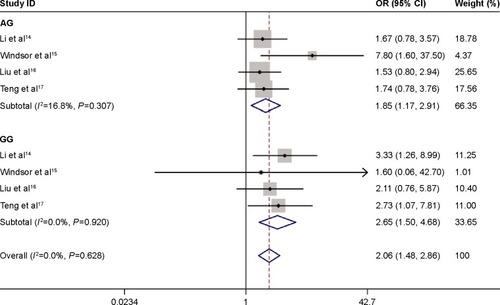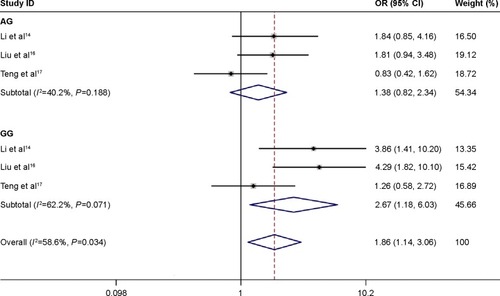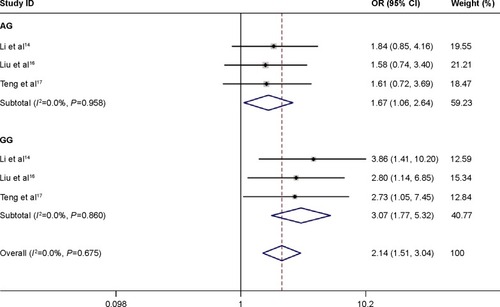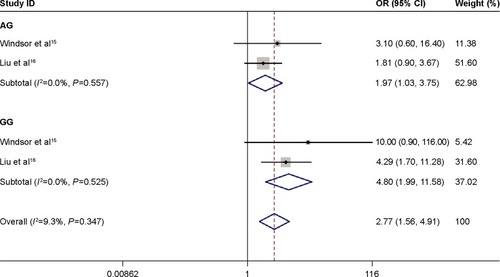Abstract
Objective
The aim of this study was to evaluate the relationship between GSTP1 polymorphisms and prognosis of osteosarcoma in patients treated with chemotherapy, by performing a meta-analysis.
Methods
The studies of effects of GSTP1 gene polymorphisms on osteosarcoma survival after chemotherapy were collected. STATA (version 12.0) was used to perform data synthesis.
Results
Six studies involving 898 participants were included. A meta-analysis was performed on studies in GSTP1 313A>G(rs1695) assessing the association between tumor response and the polymorphisms in GSTP1 (AA vs AG, AA vs GG), the pooled odds ratios (ORs) were 2.06 (95% confidence interval [CI]: 1.48–2.86, P=0.628, I2=0.0%). There was significant association between the polymorphisms in GSTP1 (AA vs AG, AA vs GG) and the events that happened, the pooled ORs were 1.86 (95% CI: 1.14–3.06, P=0.034, I2=58.6%), and there was significant association between the polymorphisms in GSTP1 (AA vs AG, AA vs GG) and survival times (overall survival and progression-free survival) in osteosarcoma patients treated with chemotherapy, and the pooled ORs were 2.14 (95% CI: 1.51–3.04, P=0.675, I2=0.0%) and 2.77 (95% CI: 1.56–4.91, P=0.347, I2=9.3%), respectively. Two studies assessed the association of polymorphisms in GSTP1 I105V (IIe/IIe vs IIe/Val, IIe/IIe vs Val/Val) with overall survival in human osteosarcoma. The pooled ORs were 1.20 (95% CI: 0.64–2.27, P=0.010, I2=73.5%). The study showed an insignificant difference in overall survival for the polymorphisms in GSTP1 (IIe/IIe vs IIe/Val, IIe/IIe vs Val/Val).
Conclusion
This meta-analysis indicated that GSTP1 polymorphisms might influence osteosarcoma risk and suggests that GSTP1 polymorphisms may be an important risk factor for osteosarcoma.
Introduction
Osteosarcoma derives from primitive bone-forming mesenchymal cells, and it is the most common malignant tumor of bones and one of the leading cause of death from cancer in children and adolescents.Citation1 The real mechanism of developing osteosarcoma is still not well understood, but its genesis and progression may be regulated by genetic factors.Citation2 Standard treatment of osteosarcoma involves neoadjuvant therapy before definitive resection of the primary tumor, followed by multiple chemotherapeutic agents after operation.Citation3 Nevertheless, more than 40% patients have a poor tumor response to chemotherapy, and the estimated survival is approximately 45%–55%,Citation4 and the 5-year overall relapse-free survival rate is approximately 65%.Citation5 According to biomarkers, individualized chemotherapy may improve the patients’ tumor response to chemotherapy and the clinical outcome. Therefore, fully understanding the role of pharmacogenetics could help establish individualized chemotherapy for patients to benefit more from chemotherapy to prolong their life. In recent years, several common gene polymorphisms, including in GSTP1, have been identified to be associated with osteosarcoma.Citation6
Glutathione S-transferases (GSTs) are a family of cytosolic enzymes, which are involved in metabolizing chemotherapeutic agents and play an important role in the detoxification of various exogenous and endogenous reactive species.Citation7,Citation8 Glutathione S-transferase p1 (GSTP1) belongs to the pi class and encodes a glutathione S-transferase. This gene is a polymorphic gene encoding differently active, functional GSTP1 proteins in xenobiotic metabolism.Citation9 GSTP1 plays a role in susceptibility to some cancers, such as breast cancer and osteosarcoma.Citation6,Citation10 The genetic polymorphisms could affect drug metabolizers and transporters, which could affect the plasma concentration of chemotherapy drugs and influence the effectiveness of chemotherapy.
Numerous studies have reported GSTP1 polymorphisms are associated with prognosis of osteosarcoma patients treated with chemotherapy, especially GSTP1 313A>G and GSTP1 I105V, but the results are inconclusive, which may be due to the limitation of the small sample size in each of published studies. Therefore, we performed a meta-analysis of the published studies to estimate the association more accurately.
Materials and methods
Ethics statement
The study was approved by the Ethics Committee of Union Hospital, Tongji Medical College, Huazhong University of Science and Technology and conforms with the provisions of the Declaration of Helsinki.
Search strategies
We searched for non-English and English articles included in PubMed, SCI, Elsevier, and CNKI database. Search terms included the following key words: glutathione S-transferase p1, GSTP1, polymorphisms, osteosarcoma, and chemotherapy. Studies up to October 2014 were included. There was no restriction on time period, population, language, or type of study. All eligible studies were retrieved, and their bibliographies were checked for other relevant publications. The computerized search was supplemented by a manual search of the bibliographies of all retrieved articles by two independent reviewers.
Inclusion/exclusion criteria of literature
The studies were included if they satisfied the following criteria:
The study design was case-control;
They had information on the relationship between GSTP1 polymorphisms and osteosarcoma risk or clinical outcome after chemotherapy;
The papers provided the size of the samples, distribution of alleles, genotypes, or other informations that could help us estimate an odds ratio and 95% confidence interval.
The studies were excluded if one of the following existed:
If they were review articles and studies that contained overlapping data;
If they did not offer the source of cases and controls or other essential information;
If more than one study from the same group occurred, we only used the most recent study or the study where complete data was available.
Statistical analysis
The following information was extracted from each eligible study by two investigators independently with the standard protocol: the name of first author, year of publication, country of origin, ethnicity of the population studied, the sample size of cases and controls, genotyping methods and allele and genotype distribution in cases and controls, tumor response after chemotherapy, overall survival, progression-free survival, event-free survival, and events after chemotherapy. Different ethnicities of the population were categorized as Caucasians, Asian. To ensure the accuracy of the extracted information, two investigators checked the data extraction results and reached consensus on all of the data extracted. If different results were generated, they would check the data again and have a discussion to come to an agreement. The results were reviewed by a third investigator and any disagreement was resolved by discussion.
Risk ratio (RR) and a 95% CI were used for presenting the statistical results for dichotomous outcomes. Weighted mean difference (WMD) and a 95% CI were employed for presenting the statistical results for continuous outcomes. Mantel–Haenszel analysis was utilized for dichotomous variables, and inverse variance method was used for continuous variables.Citation11 The statistical significance was set at P<0.05.
The difference was considered to be statistically significant if a P-value was less than 0.10 and was also quantitatively assessed by using the value of I-square (I2<25%, no heterogeneity; I2 between 25% and 50%, moderate heterogeneity; and I2>50%, high heterogeneity).Citation12 If I2<50% or P>0.10, it shows that the studies were homogeneous or slightly heterogeneous, and we used the fix effects model to combine the effect size. If I2>50% or P<0.10, indicating that the studies were moderately or highly heterogeneous, and we employed the random effects model to combine the effect size.Citation13 Statistical calculations were performed by using STATA version 12.0 (StataCorp LP, College Station, TX, USA).
Results
Search results and features of studies included
The initial search was independently executed by two reviewers, and 25 articles were preliminarily selected based on the research criteria. After screening by title and abstract, in accordance with inclusion/exclusion criteria, 19 studies were excluded. After a thorough discussion between the two reviewers, six articles were found to be related to this study. The 36 articles were then subjected to a second stage of review. Finally, a total of six studies were included for the meta-analysis. The detailed steps of the literature search are shown in . Six studies,Citation14–Citation19 covering data from a total of 898 participants, were included in this review. The information about the authors, publication year, national sources, ethnicity, method, genotype, and outcome parameter of each study are listed in . There were five studies in Asians and only one study in Caucasians. The genotype distribution in the controls of all the studies included in our meta-analysis was consistent with the Hardy–Weinberg equilibrium (HWE). Information on gene and the sample size, OR estimation, and 95% CI of each study are given in .
Table 1 Characteristics of included studies in this meta-analysis
Table 2 Patients and characteristics of the trials included in the meta-analysis
Result of meta-analysis
A meta-analysis was performed on studies relating to GSTP1 313A>G(rs1695) to assess the association between tumor response in osteosarcoma patients treated with chemotherapy and the polymorphisms in GSTP1 (AA vs AG, AA vs GG). The pooled ORs were 2.06 (95% CI: 1.48–2.86, P=0.628, I2=0.0%) (). There was significant association between the polymorphisms in GSTP1 (AA vs AG, AA vs GG) and the events that happen in osteosarcoma patients treated with chemotherapy, and the pooled ORs were 1.86 (95% CI: 1.14–3.06, P=0.034, I2=58.6%) (). There was significant association between the polymorphisms in GSTP1 (AA vs AG, AA vs GG) and survival times (overall survival and progression-free survival) in osteosarcoma patients treated with chemotherapy, the pooled ORs were 2.14 (95% CI: 1.51–3.04, P=0.675, I2=0.0%) and 2.77(95% CI: 1.56–4.91, P=0.347, I2=9.3%), respectively ( and ).
Figure 2 Association between GSTP1 313A>G(rs1695) polymorphism and tumor response in osteosarcoma patients treated with chemotherapy.
Abbreviations: OR, odds ratio; CI, confidence interval.

Figure 3 Association between GSTP1 313A>G(rs1695) polymorphism and events that occur in osteosarcoma patients treated with chemotherapy.
Abbreviations: OR, odds ratio; CI, confidence interval.

Figure 4 Association between GSTP1 313A>G(rs1695) polymorphism and overall survival in osteosarcoma patients treated with chemotherapy.
Abbreviations: OR, odds ratio; CI, confidence interval.

Figure 5 Association between GSTP1 313A>G(rs1695) polymorphism and progression-free survival in osteosarcoma patients treated with chemotherapy.
Abbreviations: OR, odds ratio; CI, confidence interval.

Two studies assessed the association of polymorphisms in GSTP1 I105V (IIe/IIe vs IIe/Val, IIe/IIe vs Val/Val) with overall survival in human osteosarcoma. The pooled ORs were 1.20 (95% CI: 0.64–2.27, P=0.010, I2=73.5%) (). The study showed an insignificant difference in overall survival for the polymorphisms in GSTP1 (IIe/IIe vs IIe/Val, IIe/IIe vs Val/Val).
Publication bias
We did not draw funnel plots to demonstrate publication bias, because the number of studies included was comparatively small.
Discussion
The GST gene is a target gene which can regulate human metabolism, the immune and endocrine systems, and has a close relationship with the occurrence of osteosarcoma. It has been confirmed that different GST genes have different conversion efficiencies and enantioselectivities for various toxins which may lead to cancer.Citation8,Citation20 GSTP1 is the most important member of GST family, which takes part in the detoxification of electrophilic compounds by glutathione conjugation.Citation21 GSTP1 polymorphism links to enzymatic activity, and the polymorphism may confer susceptibility to cancers. A number of studies have focused on GSTP1 polymorphism and the risk of various kinds of cancers, including osteosarcoma, ovarian carcinoma, prostate cancer, and bladder cancer,Citation6,Citation8,Citation22,Citation23 but the polymorphism was not considered to be linked with susceptibility to the chemotherapy of osteosarcoma patients. This study was performed to investigate the association between GSTP1 polymorphism and chemotherapy of osteosarcoma.
To the best of our knowledge, our study is the first meta-analysis assessing the association between GSTP1 polymorphism and chemotherapy of osteosarcoma. In this study, an obvious association among tumor response, events, and survival times was found in GSTP1 313A>G(rs1695) under the recessive model, but there was no obvious association between survival times and chemotherapy of osteosarcoma in GSTP1 I105V. We concluded that the GSTP1 313A>G(rs1695) polymorphism may be associated with chemotherapy of osteosarcoma. Although we use this comprehensive analysis to demonstrate the association between GSTP1 polymorphism and chemotherapy of osteosarcoma, some limitations still exist. On the one hand, not all of the studies used controls that were population-based, and some risk factors such as age, family history, and environmental factors were unadjusted estimates, which may cause confounding bias. And on the other hand, the number of studies and the number of samples included in this meta-analysis were relatively small. Therefore, we need additional studies with larger sample size and providing more detailed information to assess the effect of GSTP1 313A>G(rs1695) and I105V polymorphism on osteosarcoma with chemotherapy. In spite of the above shortcomings, our study still had the advantage that a meta-analysis of the association of GSTP1 polymorphism on chemotherapy of osteosarcoma is statistically more powerful than any single study, and we found that I105V gene polymorphism did not show an obvious association with chemotherapy of osteosarcoma. Whether GSTP1 polymorphism can be used as an indicator of the risk of osteosarcoma in patients and as a prognostic marker in osteosarcoma patients undergoing chemotherapy warrants further study.
Acknowledgments
This research was supported by the National Natural Science Foundation of China (grant number 81372004).
Disclosure
The authors report no conflicts of interest in this work.
References
- OttavianiGJaffeNThe epidemiology of osteosarcomaCancer Treat Res200915231320213383
- FuchsBZhangKSchabelABolanderMESarkarGIdentification of twenty-two candidate markers for human osteogenic sarcomaGene20012781–224525211707342
- LonghiAErraniCDe PaolisMMercuriMBacciGPrimary bone osteosarcoma in the pediatric age: state of the artCancer Treat Rev200632642343616860938
- BielackSSKempf-BielackBDellingGPrognostic factors in high-grade osteosarcoma of the extremities or trunk: an analysis of 1,702 patients treated on neoadjuvant cooperative osteosarcoma study group protocolsJ Clin Oncol200220377679011821461
- FosterLDallGFReidRWallaceWHPorterDETwentieth-century survival from osteosarcoma in childhood. Trends from 1933 to 2004J Bone Joint Surg Br20078991234123817905964
- CaroniaDPatiño-GarciaAPeréz-MartínezAEffect of ABCB1 and ABCC3 polymorphisms on osteosarcoma survival after chemotherapy: a pharmacogenetic studyPLoS One2011610e2609122016816
- HayesJDPulfordDJThe glutathione S-transferase supergene family: regulation of GST and the contribution of the isoenzymes to cancer chemoprotection and drug resistanceCrit Rev Biochem Mol Biol19953064456008770536
- HengstlerJGKettAArandMGlutathione S-transferase T1 and M1 gene defects in ovarian carcinomaCancer Lett19981301–243489751255
- WeissSTRabyBARogersAAsthma genetics and genomics 2009Curr Opin Genet Dev200919327928219481925
- MiyakeTNakayamaTKagaraNAssociation of GSTP1 methylation with aggressive phenotype in ER-positive breast cancerAnticancer Res201333125617562324324107
- MantelNHaenszelWStatistical aspects of the analysis of data from retrospective studies of diseaseJ Natl Cancer Inst195922471974813655060
- HigginsJPThompsonSGDeeksJJAltmanDGMeasuring inconsistency in meta-analysesBMJ2003327741455756012958120
- DerSimonianRLairdNMeta-analysis in clinical trialsControl Clin Trials1986731771883802833
- LiJZTianZQJiangSNFengTEffect of variation of ABCB1 and GSTP1 on osteosarcoma survival after chemotherapyGenet Mol Res20141323186319224841650
- WindsorREStraussSJKallisCWoodNEWhelanJSGermline genetic polymorphisms may influence chemotherapy response and disease outcome in osteosarcoma: a pilot studyCancer201211871856186721887680
- LiuSYiZLingMPredictive potential of ABCB1, ABCC3, and GSTP1 gene polymorphisms on osteosarcoma survival after chemotherapyTumour Biol201435109897990424996541
- TengJWYangZMLiJXuBPredictive role of glutathione S-transferases (GSTs) on the prognosis of osteosarcoma patients treated with chemotherapyPak J Med Sci20132951182118624353716
- YangLMLiXHBaoCFGlutathione S-transferase P1 and DNA polymorphisms influence response to chemotherapy and prognosis of bone tumorsAsian Pac J Cancer Prev201213115883588623317281
- ZhangSLMaoNFSunJYPredictive potential of glutathione S-transferase polymorphisms for prognosis of osteosarcoma patients on chemotherapyAsian Pac J Cancer Prev20121362705270922938445
- HuXBensonPJSrivastavaSKGlutathione S-transferases of female A/J mouse liver and forestomach and their differential induction by anti-carcinogenic organosulfides from garlicArch Biochem Biophys199633621992148954567
- AutrupHGenetic polymorphisms in human xenobiotica metabolizing enzymes as susceptibility factors in toxic responseMutat Res20004641657610633178
- YuZLiZCaiBAssociation between the GSTP1 Ile105Val polymorphism and prostate cancer risk: a systematic review and meta-analysisTumour Biol20133431855186323494181
- WangZXueLChongTLiHChenHQuantitative assessment of the association between glutathione S-transferase P1 Ile105Val polymorphism and bladder cancer riskTumour Biol20133431651165723483487


